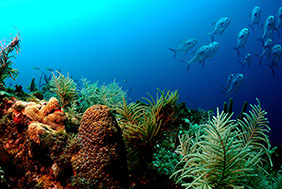Featured Archive - 2019 Publications
Below is a sampling of publications generated by NOAA's coral ecosystem activities in 2019. To access a complete list of NOAA coral ecosystem related publications, use the CoRIS Geoportal
(https://www.coris.noaa.gov/search/) search tool.
Due to climate change, coral reefs are now being subjected to extreme marine heatwave (MHW) conditions. Leggat et al. show that large-scale mortality due to MHWs and microbial colonization leads to a previously undescribed rapid dissolution of the coral skeleton.
Highlights of this publication are:
- Marine heatwaves lead to rapid coral mortality and microbial biofilm formation.
- Microbial metabolic activity results in rapid dissolution of the coral skeleton.
- Dissolution reduces skeletal hardness and density and increases porosity.
Based on interviews with collectors, a synthesis of trip ticket results, and population abundance estimates, the long-term stability of the octocoral fishery is not likely to change significantly. The social dynamics of the aquarium industry to seek colorful, rare, and exotic marine species for home aquaria places octocorals at the lower end of the list of desired species. For multiple sampling periods, over a decadal period (1999-2009) in the Florida Keys, where most octocoral collection occurs, abundance estimates presented for 15 species illustrate that population sizes are large (tens of millions to hundreds of millions of colonies, per species) and abundance is stable or increasing.
NOAA's Coral Reef Conservation Program funded a study from 2013 to 2015 to determine the feasibility of monitoring turbidity plumes in reef waters for three U.S. jurisdictions, one of which was the Southeast Florida Shelf and northern Florida reef tract. This report presents the results of that study. It shows that with care, satellite ocean color can be used to remotely monitor sources and instances of coastal ocean turbidity.
This report outlines human dimensions information relevant to coral reef resources in the United States Virgin Islands (USVI). The findings here are derived from a combination of data gathered through household surveys conducted from February to April 2017, and additional secondary sources of socioeconomic information for the region. Survey results show that USVI residents participate in beach recreation and swimming most frequently. Additionally, 40% of residents indicated that they participate in fishing or gathering of marine resources. Perceptions concerning marine resource condition tend to vary amongst USVI residents, they generally support a range of potential marine management policies and regulations, and are moderately familiar with the various threats facing coral reefs. Further, 92% of residents agree that coral reefs are important to their culture.
This report outlines human dimensions information relevant to coral reef resources in the
Commonwealth of Northern Mariana Islands (CNMI). The findings here are derived from a combination
of data gathered through household surveys conducted from August 2016 to April 2017, and additional
secondary sources of socioeconomic information for the region. Survey results show that CNMI
residents participate in beach recreation and swimming most frequently. Additionally, 38% of residents
indicated that they participate in fishing or gathering of marine resources. Perceptions concerning
marine resource condition tend to vary amongst CNMI residents, they generally support a range of
potential marine management policies and regulations, and are moderately familiar with the various
threats facing coral reefs.
The project team assessed the relative resilience of reef sites at two depths along areas of West and South-West Maui ("leeward Maui") in March of 2018. The surveys were conducted as a collaborative effort with the Hawai'i Department of Aquatic Resources, The Nature Conservancy, and community organizations. This report presents findings from meeting the following project objectives: 1) assess benthic cover comparisons among sites and depths, 2) complete resilience assessment including relative resilience and rankings for two depths, 3) conduct analyses that determine the primary drivers of differences in resilience between sites, and 4) develop a framework for using the resilience analysis outputs to identify and prioritize potential management actions to support the resilience of coral reefs in Maui.


